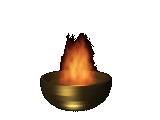

The Moon represents instinctive actions, the past, and events from our childhood which affect us as adults. It is also concerned with the way in which we take in other people's energy and reflect it back to them. One can see how this idea is related to structure of the moon: unlike the Sun, which is a source of energy in its own right, the Moon can only reflect the light which falls on it. The Moon represents a passive, ying, form of energy, in contrast to the Sun's active yang energy.
The Moon is the only satellite of the Earth. At present, many scientists believe that it was formed early in the history of the Solar System when a large body hit the Earth.
The Moon rotates about its own axis in about the same time - 29.5 days - that it takes to orbit the Earth. This means that we only see one side of it. The part we can's see has been called the "dark" side, even though it is, of course, no darker than the rest. Space probes, such as the Luna series, have shown us the features on the side which we cannot see from Earth.
Click here to download ZIP-format AVI file of Moon fly-past (539K)
| Mechanical Data | |
| Diameter | 3,475 km |
| Average distance from Earth | 284,400 km |
| Atmosphere | none |